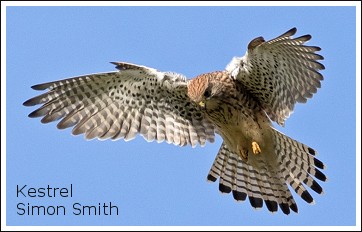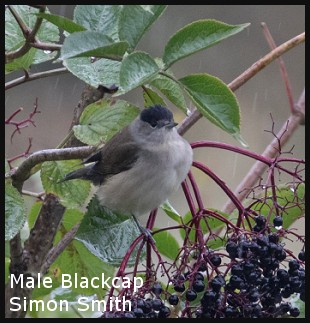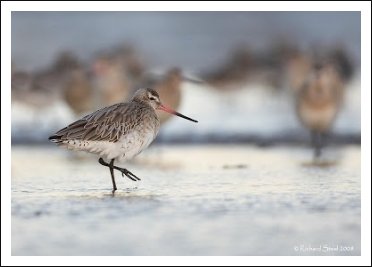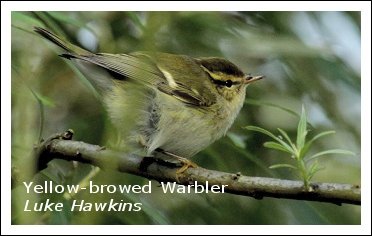
Knutsford Ornithological Society long weekend in the North-east - 28th September to 1st October 2017
It's been some years now since we last went up to the north-east for a long weekend away, more recently Hilbre Island seems to have taken over at this time of the year. We always used to stay on Lindisfarne itself but nowadays organising accommodation months in advance in a "traditional" hotel for a disparate group of people has become a challenge few are willing to take on. Instead, and where available, we tend to use Premier Inns, it's much easier to say to members "between these two dates we will be staying at such a such a Premier Inn, if you're coming along book yourselves in and inform the appointed trip leader", it then only remains to organise the transport.
This time we stayed at the Ashington Premier Inn about an hours drive from Lindisfarne, midway between the island and the RSPB's Saltholme reserve. All these Premier Inns are much of a muchness, clean rooms, friendly and efficient staff etc. although at this particular establishment a problem with the fish fryer meant that no fish dishes were available and there was a subsequent run on the remaining items. As a consequence on the second night some of the party chose to drive to an Italian restaurant just down the road in the small town of Newbiggin-by-the-sea and on the third night we all went! Due Fratelli - excellent and cheaper that the Premier Inn!
Day #1 Thursday 28th September
After driving independently over the Pennines we all met up at 12:30pm in the cafe on the Saltholme RSPB reserve for a cup of tea or a coffee and a sandwich (although I noticed a couple of the usual suspects enjoying plates of fish and chips!)
Saltholme is quite a big reserve especially if you choose to follow the long "Wilderness trail", a distance of 1.3 miles through some pretty rough ground. We gave this a miss on this occasion and headed for the Haverton viewpoint overlooking the Haverton Hole pools from where a Bittern had been seen earlier in the morning. No Bittern but a good array of wildfowl including Mute Swan, Mallard, Gadwall, Little Grebe and Teal with a Little Egret plus a selection passerines on the walk over to the viewpoint. the long "Wilderness trail", a distance of 1.3 miles through some pretty rough ground. We gave this a miss on this occasion and headed for the Haverton viewpoint overlooking the Haverton Hole pools from where a Bittern had been seen earlier in the morning. No Bittern but a good array of wildfowl including Mute Swan, Mallard, Gadwall, Little Grebe and Teal with a Little Egret plus a selection passerines on the walk over to the viewpoint.
There was plenty of activity on the pools in front of the Saltholme Pools hide and the surrounding area with big flocks of geese - Canada, Greylag and c.50 Barnacle. In and around the water Kingfisher, Wigeon, Black-tailed Godwit, Lapwing, Redshank and large numbers of Golden Plovers; a small flock of Linnets flew in and fed at the water's edge - very wary of a Kestrel hovering overhead. It was Len Mason who had perhaps the best birds of the day from the Phil Stead hide from where he recorded Sparrowhawk, Peregrine Falcon and two Marsh harriers.
We had hoped for a trip list of around 100 species, so the 43 at Saltholme was a good start.
Day #2 Friday 29th September - Cresswell, Hauxley, Seahouses, Lindisfarne.
Our first port of call on the Friday was Cresswell Pond a location I first visited on June 19th 1974. We'd travelled north for a wedding and at the reception all the men vanished to a smoke filled room to watch the World Cup match between Scotland and Brazil (0-0 - Bremner, Daglish, Jordan et al.)I remember getting a pass-out the next morning and had my first ever Spotted Redshanks at the Pond! No Spotted Redshanks this time but it's still a good little spot with an Avocet feeding in the shallows; relatively new to the area according to a local birder who we met and unheard of the last time I visited! Curlews and Lapwings fed on a field sloping down to the water's edge. A single Snipe dropped in and a lone Swallow powered over heading steadily south. A pair of Stonechats perched precariously on the tangle of vegetation opposite the pool where a large mixed flock of c 300 Goldfinches and Linnets fed on the tall seed bearing plants (I recognised Mugwort but none of the others - where's JS when you need him!A short drive up the A1068 found us at the splendid Hauxley Nature reserve run by the Northumberland Wildlife Trust and a band of hard working volunteers.  There are six hides situated at regular intervals along the 3K path that runs around the main lake, it began raining as we arrived and we only visited two of these but spent quite a time in them when the rain became heavier. There are six hides situated at regular intervals along the 3K path that runs around the main lake, it began raining as we arrived and we only visited two of these but spent quite a time in them when the rain became heavier.
The top hide overlooked a small island where we had good views of two Barnacle Geese, Little Grebes and a group of 15 Snipe - great images through the 'scopes.
The Skua hide afforded distant views of the sea and, immediately in front, a feeding station surrounded by dense vegetation. This was attracting a wide range of species and we added quite a few new ones to the trip list - Blue, Great and Coal Tits, Dunnock, Chaffinch and Song Thrush. Male and female Blackcaps showed well as they helped themselves to elderberries hanging down over the feeders. 
The Wildlife Discovery Centre is an interesting structure who's walls are constructed from hay bales! A roomy cafe tempted us of course and we enjoyed our drinks in front of large picture windows overlooking the lake and another feeding station; this is an excellent setup and well worth a visit any time of the year if you happen to be in the area. The harbour at Seahouses was quiet but Eiders in various plumages floated in the sea close in to the quayside and on the rocks on the other side we had excellent views of Ringed Plovers, Turnstones and Rock Pipits that posed well for Simon's camera. It was some time after high tide when we drove over the causeway onto Lindisfarne and parked on the first car park on the left (
£
4:50 for the day) , the one we used to use is now reserved for coaches. , the one we used to use is now reserved for coaches.
Inevitably we started off in another cafe before exploring the town and harbour, this time 1st Class Food a new one since we were last on the island. A Barn Owl was quite a surprise for Bob Groom and Len Mason as they made their way ahead of us towards the harbour where we had a good selection of species - Ringed Plover, Grey Plover and bar-tailed Godwits feeding on the exposed mud; a passing Wheatear added to our list and Bob had a family of Swallows in the priory as we made our way to that side of the island.
Day #3 Saturday 30th September - Lindisfarne
A prompt 8:00am start on Saturday for the 75' drive back up to Lindisfarne before the 09:35am deadline for safe crossing before the causeway became flooded, I'm sure there's a built in safety factor to the published times but we weren't about to take any chances.
The weather was fine with blue skies and just a few fluffy white clouds as we set off but, pleasant as this was, a westerly wind was blowing across from the mainland - the worst possible direction for birding! Few birds were about in the harbour just a scattering of Eiders and there was no exposed mud for the waders we'd seen the previous day. Flocks of Golden Plovers flew overhead and a few Meadow Pipits flew up in front of us as we headed over to the Gertrude Jekyll gardens, a little oasis of fading autumnal colour sheltering behind its granite walls. Golden Plovers and Turnstones were sitting out the tide along the rocky foreshore as we headed in the direction of Emmamuel Point via the new hide overlooking the Lough where we recorded Little Grebe, Shoveler, Mallard, Gadwall, Coot and Moorhens. - the worst possible direction for birding! Few birds were about in the harbour just a scattering of Eiders and there was no exposed mud for the waders we'd seen the previous day. Flocks of Golden Plovers flew overhead and a few Meadow Pipits flew up in front of us as we headed over to the Gertrude Jekyll gardens, a little oasis of fading autumnal colour sheltering behind its granite walls. Golden Plovers and Turnstones were sitting out the tide along the rocky foreshore as we headed in the direction of Emmamuel Point via the new hide overlooking the Lough where we recorded Little Grebe, Shoveler, Mallard, Gadwall, Coot and Moorhens.
We walked along the beach that runs from Emmanuel Head towards Snipe Point, found a convenient sea-washed log and indulged in a little sea watching but, it was very quiet out there - Gannets  dived for fish and a Red-throated Diver provided good views through the 'scopes as it drifted along in front of us. Quite disappointing compared with previous visits but we were very comfortable sheltering out of the wind in the lee of the tall sand dunes. dived for fish and a Red-throated Diver provided good views through the 'scopes as it drifted along in front of us. Quite disappointing compared with previous visits but we were very comfortable sheltering out of the wind in the lee of the tall sand dunes.
After passing back through the dunes we arrived at the top of the long Lonnen (track) leading back to the town and it was here that our luck changed for the better. We met up with a young birder by the name of Luke Hawkins who kindly pointed us in the direction of a clump of willow where he'd just been photographing a Yellow-browed Warbler, a rare vagrant to Britain that occurs from time to time, blown off course on it's migration from breeding grounds in northern Russia east of the Urals to south-east Asia, we spent some time there and all present had good views of this tiny little visitor - many thanks Luke!
We had intended to leave the island after lunch and visit Budle Bay but instead we returned to catch the warbler again as not all the party had seen it; it was still there and performed well for us. Also there Willow Warblers, Chiffchaffs, a first year Redstart - a Sparrowhawk shot through the clump, so close we heard it's wings as it wooshed past us. Over the meadow between us and the dunes a Short-eared Owl hunted!
Day #4 Sunday 1st October - Leighton Moss
We left Ashington at 9:00am and drove across to the west coast via the A1, A69 and the M6 to Leighton Moss - just over an hours drive from home. The weather was pretty dismal, overcast with occasional drizzle but we did quite well and added eight new species to the list. The Marsh Tits at Leighton never seem to let us down and they were using the feeders outside the visitor centre along with Nuthatches and Greenfinches. Pride of place must go to the Purple Heron seen by Bob from the Jackson hide, species #93 and finally a Great Crested Grebe to leave us just 6 short of our 100 species target over the four days!
Species recorded during our long weekend 28th September to 1st August 2017
Skylark, Stock Dove, Goldfinch, Woodpigeon, Swallow, Oystercatcher, Cormorant, Jackdaw, Stock Dove, Tree Sparrow, Starling, Mute Swan, Little Egret, Moorhen, lapwing, Coot, Long-tailed Tit, Little Grebe, Mallard, Gadwall, Great Tit, Blue Tit, Kestrel, Wren, Carrion Crow, Teal, Canada Goose, Marsh harrier, Peregrine Falcon, Greylag Goose, Redshank, Grey Heron, Meadow Pipit, Curlew, Lesser Redpoll, Tufted Duck, Shoveler, Golden Plover, Kingfisher, Black Swan, Wigeon, Black-tailed Godwit, Black-headed Gull, Linnet, Barnacle Goose, Herring Gull, Pied Wagtail, Reed Bunting, Water Rail, Coal Tit, Great Black-backed Gull, Lesser Black-backed Gull, Avocet, Snipe, Collared Dove, Rook, Chiffchaff, Magpie, Pheasant, Stonechat, Blackbird, Robin, Blackcap, Bullfinch, Gannet, House Sparrow, Song Thrush, Dunnock, Chaffinch, Turnstone, Rock Pipit, Eider, Grey Wagtail, Dunlin, Ringed Plover, Bar-tailed Godwit, Wheatear, Barn Owl, Short-eared Owl, Sparrowhawk, Redwing, Fieldfare, Redstart, Yellow-browed Warbler, Willow Warbler, Red-throated Diver, Buzzard, Marsh Tit, Greenfinch, Nuthatch, Jay, Goldcrest, Great Crested Grebe, Purple Heron
[ ✓ 94]
|
|
|